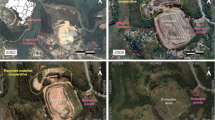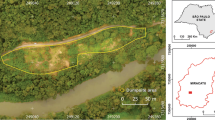Abstract
This paper deals with the engineering-geological investigation of uncontrolled dumpsites that are abundant in post-communist countries. The sites may be redeveloped in an optimal manner by using the applied methodology of engineering-geological investigations. The research tool is a case study dealing with hazardous uncontrolled dumpsites chemically contaminated by various substances, particularly carcinogenic chromium. The dumpsite is located in the alluvial sediments of an oxbow lake of the Nitra River in the Slovak Republic. The hazard is seen in the fact that the alluvial sediments are permeable and thus the contamination may spread easily. At the same time, it is located near a river, which makes the hazard greater. Apart from the risk of contamination, another risk is related to the methane generated by the dumpsite and thus the risk of self-ignition. In order to identify the uncontrolled dumpsite body, the research was grounded in the different physical properties of the diverse geological environments. Quasi-homogenous blocks of the dumpsite body and its alluvial surroundings were well identified by using the combined three geophysical methods, namely dipole electromagnetic profiling (DEMP), electrical resistance tomography (ERT) and spontaneous polarization (SP). In order to eliminate the risk of contamination spread, redevelopment measures for the uncontrolled dumpsite in the form of sealing walls and surface sealing foil were proposed. A system of methane drainage boreholes was proposed to eliminate the risk of self-ignition. The methodology in this case study is well applicable for other uncontrolled dumpsites, which is an important outcome of the study.














Similar content being viewed by others
References
Al-Fares, R. A., Al-Jarallah, R. S., & Abdulsalam, Z. (2010). An initial pilot scale investigation of Al-Jahra waste disposal site using electrical resistivity (ER) surveys. Kuwait Journal of Science & Engineering, 37(2 B), 25–42.
Cardarelli, E., & Di Filippo, G. (2004). Integrated geophysical surveys on waste dumps: evaluation of physical parameters to characterize an urban waste dump (four case studies in Italy). Waste Management & Research, 22(5), 390–402.
Chambers, J. E., Kuras, O., Meldrum, P. I., Ogilvy, R. D., & Hollands, J. (2006). Electrical resistivity tomography applied to geologic, hydrogeologic, and engineering investigations at a former waste-disposal site. Geophysics, 71(6), B231–B239.
Critto, A., Carlon, C., & Marcomini, A. (2003). Characterization of contaminated soil and groundwater surrounding an illegal landfill (S. Giuliano, Venice, Italy) by principal component analysis and kriging. Environmental Pollution, 122(2), 235–244.
Dar, S. N., Wani, M. A., Shah, S. A., & Skinder, S. (2018). Identification of suitable landfill site based on GIS in Leh, Ladakh Region. GeoJournal, 1–15.
Di Fiore, V., Cavuoto, G., Punzo, M., Tarallo, D., Casazza, M., Guarriello, S. M., & Lega, M. (2017). Integrated hierarchical geo-environmental survey strategy applied to the detection and investigation of an illegal landfill: a case study in the Campania Region (Southern Italy). Forensic Science International, 279, 96–105.
Dumont, G., Robert, T., Marck, N., & Nguyen, F. (2017). Assessment of multiple geophysical techniques for the characterization of municipal waste deposit sites. Journal of Applied Geophysics, 145, 74–83.
Kawai, S., Shimaoka, T., & Sakaguchi, S. (2016). Behavior of soft plastic in illegally dumped solid waste according to effective stress changes. Japanese Geotechnical Society Special Publication, 2(52), 1798–1801.
Król, S. (2016). Illegal landfill sites in Poland. World Scientific News, 48, 164–170.
Landrigan, P. J., & Gross, R. L. (1981). Chemical wastes - illegal hazards and legal remedies. American Journal of Public Health, 71(9), 985–987.
Mazza, A., Piscitelli, P., Neglia, C., Rosa, G., & Iannuzzi, L. (2015). Illegal dumping of toxic waste and its effect on human health in Campania, Italy. International Journal of Environmental Research and Public Health, 12(6), 6818–6831.
Ruffell, A., Pringle, J. K., Graham, C., Langton, M., & Jones, G. M. (2018). Geophysical assessment of illegally buried toxic waste for a legal enquiry: a case study in Northern Ireland (UK). Environmental Forensics, 1–14.
Seeboonruang, U. (2016). Geographic information system–based impact assessment for illegal dumping in borrow pits in Chachoengsao Province, Thailand. Geological Society of America Special Papers, 520, 393–405.
Sharma, A., Gupta, A. K., & Ganguly, R. (2018). Impact of open dumping of municipal solid waste on soil properties in mountainous region. Journal of Rock Mechanics and Geotechnical Engineering, 10(4), 725–739.
Shevchuk, R. M. (2018). Technique for satellite monitoring of illegal amber mining territories based on integrated Landsat and sentinel data processing. Journal of the Georgian Geophysical Society, 21(1).
Wu, T. N., & Huang, Y. C. (2006). Detection of illegal dump deposit with GPR: case study. Practice Periodical of Hazardous, Toxic, and Radioactive Waste Management, 10(3), 144–149.
Yannah, M., Martens, K., Van Camp, M., & Walraevens, K. (2019). Geophysical exploration of an old dumpsite in the perspective of enhanced landfill mining in Kermt area, Belgium. Bulletin of Engineering Geology and the Environment, 1–13.
Acknowledgements
The authors also thank the Faculty of Mining and Geology, VŠB – Technical University of Ostrava, for the support of the project (SP2018/33) which is the base of this article.
Author information
Authors and Affiliations
Corresponding author
Additional information
Publisher’s note
Springer Nature remains neutral with regard to jurisdictional claims in published maps and institutional affiliations.
Rights and permissions
About this article
Cite this article
Marschalko, M., Putiška, R., Yilmaz, I. et al. Investigation of a hazardous uncontrolled dumpsite in an oxbow lake of the Nitra River for pollution potential: a case study. Environ Monit Assess 192, 49 (2020). https://doi.org/10.1007/s10661-019-8031-x
Received:
Accepted:
Published:
DOI: https://doi.org/10.1007/s10661-019-8031-x




